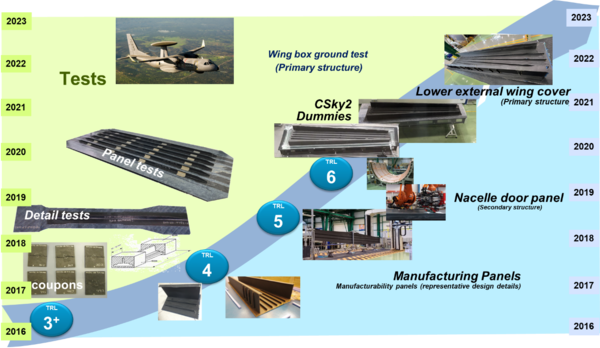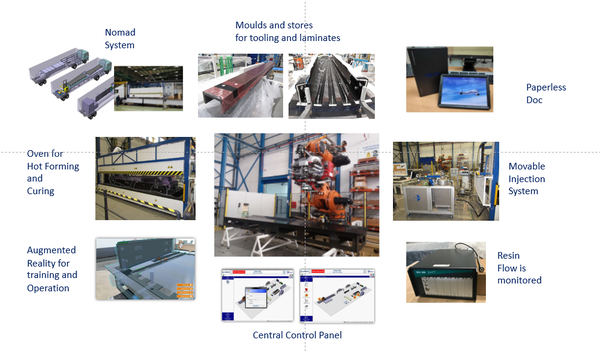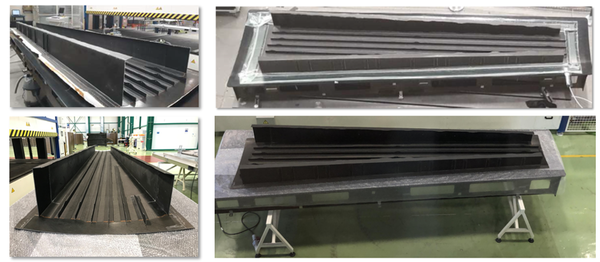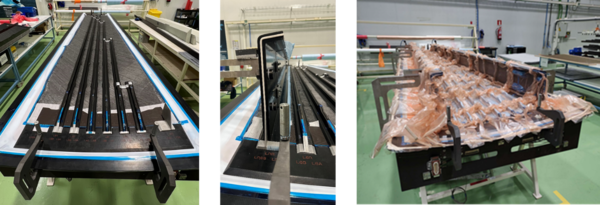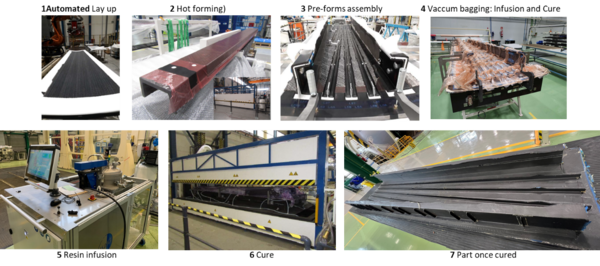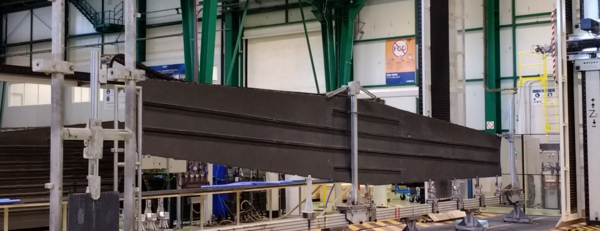1. Technology Maturation
As described in reference [Ref. 1], Airbus Defence and Space launched and updated a roadmap for Infusion Technology (See Figure 1). Industrial approach was de-risked by means of the so called program APOLO: how to make feasible operations, taking advantage of the opportunities for saving and the logistic benefits, when dealing with dry fibre. In particular, automated lay-up processes where identified as an enabler to develop design and manufacturing concepts at external facilities, before specifying industrial means to implement for mass production.
Simplified sub-scaled and full scaled demonstrators were designed and manufactured by using a commercial material (Hi tape ®/RTM6®) as potential candidate to be qualified. Other material alternatives were evaluated to select a good future product, with a proper technical and cost balance. The demonstrators were focused on the integration between stiffeners, spars and skins, by using pre-designs for the outer wing targeted by Clean Sky 2.
Several levels of the test pyramid where built [Ref. 1], improving in parallel manufacturing capabilities, even creating a new patent proposal for mastering the challenge of dimensional tolerances for complex geometry. The technological contribution of FIDAMC was crucial to speed-up the manufacturing of flat structural panels and to achieve the goals for structural testing [Ref. 3]. Since the Hi tape® has evolved with the purpose of enabling more efficient automated lay-up and hot forming operations, a wider set of tests, within an extended qualification program. The test pyramid has been enriched, providing the go ahead for entering into development for mass production programs.
Other internal programs such as MALTA and CERTERIN have contributed to reinforce the maturity level, not only for monolithic but for automated sandwich structures by dry fibre and infusion technology.
2. Innovative industrial means approach
Clean Sky 2 created the framework to implement an innovative path to obtain the lower skin component. The ambition aimed at exploring current and future state of the art compatible with an Industry 4.0 approach. Relying on the most modern Automated Fibre Placement technology for dry fibre tape, a nomad and light system of industrial means had to be developed. The success has been based on combining a flexible and nomad equipment, able to demonstrate its performance at real industrial facilities, as well as to be agile to be upgraded for further R&T improvements, thanks to its specified portability [Ref. 2 & 4]
It has been possible due to the main requirements, establishing it is an out-of-autoclave process. Moreover, infusion process are feasible by unifying industrial means for hot forming, infusion and curing; even though a high integration level is required for the manufactured part. The systems allows to work at higher temperatures of injection, hot forming and curing than the conventional similar processes devoted to typical epoxy systems.
For a nomad system, it resulted as mandatory to rely on the lightness of composite moulds. A step beyond was ambitioned by using the infusion technology even for the whole set of moulds: from forming to curing tools.
The integration of automation has been a key factor, by using not only automated lay-up machines but also creating an automated centre of thermo-infusion. In addition, an augmented reality application has been developed to be used during the training of workforce and for the operative deployment of the manufacturing process. (See Figure 2).
3. Dummies for industrial system development and reaching aerospace standards
Mtorres developed not only the innovative system, in close co-operation with Airbus Defence and Space, but also jointly contributed to deploy the methodology to make far agile a “countdown based development”. The set of challenges was split into 9 pillars: from AFP lay-up to final inspection, passing through very relevant steps such as forming, moulds, infusion etc. The sub-pillars were stated too: more than 60 topics were focused to be tackled [Ref. 2]. Some of the most important contributors are highlighted hereafter since they made feasible to deploy the demanding challenge in a short period: 18 months, even interacting with a parallel fine tuning of product design.
3.1. Set up dummies by using a proprietary “equivalent” material
An equivalent raw material (similar width format unidirectional tape) was proposed to speed up maturity trials, shorten delivery lead times and demonstrate the system capabilities before using the aerospace material. An additional advantage comes from raw material cost reduction when using such a dummy material. Mtorres developed internally the mentioned equivalent material, by using commercial dry fibre, enhancing it by means of improvements for hot forming and infusion. Even when the material presents differences with the Hi tape parameters for laying-up and hot forming, permeability of both materials showed to be similar from a practical point of view. It allowed to use the same infusion resin for both cases: dummies and aerospace component (RTM6). The differences on aerial weight and ply thickness were taken into account, respecting general laws for stacking sequences.
A subscale component and two dummies were manufactured for agile development purpose. The first full scale dummy was manufactured at Mtorres facilities (Mtorres shop floor to make easier a setup of process and means). The second one was replicated at Airbus facilities in Cadiz to validate not only the industrial means, but the actual industrial environment, including the skills of workforce highly skilled for serial production of aerospace components.
3.2. Set up of automated fibre placement
The dummies have been manufacturing by laying up at external facilities to the final use of the nomad system. Three main elements have been moved when necessary: moulds, head of AFP machine and laid-up preforms, showing the flexibility of the concept and the industrial means. Both, the dummy and the aerospace materials have been manufactured by using the same AFP heating system to activate the binders, by fine tuning of their corresponding parameters. Different UD tapes require a customized approach, by using the same industrial means.
3.3. Dummies as enablers
Dummy components have succeeded to speed up direct training, to improve ancillaries’ evolution for mass aerospace components deliveries, to validate infusion simulation, to make robust dimensional measurements (e.g. fibre fraction measure, thickness tolerance compliance) and methodology for non-destructive testing. See Figure 3). A dissemination benefit, as a must for European funded programs, has been achieved by means of physical evidences of level of maturity, even by international composites shows (E.g. JEC award, Paris 2022)
4. Structural lower skin development
Since the prior test pyramid had been developed by manufacturing industrial means other than the innovative system, the first industrial cross-check consisted of a subsequent flat and wing skin validation panels (See Fig. 4), manufactured by the aerospace raw materials intended for the final component, with the new means at the industrial plant of Airbus in Cadiz.
Dummies methodology has been used for the component to be delivered, including the approach by sub-scale component to check the fine tuning parameters to be implemented for the aircraft lower skin (hot forming, positioning, ancillaries, permeability, inlets distribution, infusion flow, curing etc)
The key dimensional parameters for assembly have been the main drivers to adjust the manufacturing process: thickness distribution (accurate tolerances for the interfaces areas at wing root and tip), spar to skin angular tolerances and position of stringers (to enable assembly of metallic ribs) and internal health, preventing local porosity zones.
The automated lay-up has been carried out at Mtorres facilities as well, by using and end effector for dry fibre 12.4 mm width unidirectional tape of Hi tape®. The grade of Hi tape used for the component corresponds to the upgraded version with lower process temperature thanks to the commercially named V100 veil. The skin has been directly laid up on the female tool, having been guaranteed its robust placement and ulterior transport to Airbus facilities. Pre-forms for stringers and spars were also laid up on flat tools. Hot forming at 120 C has been set up to shape T stringers and J-shape spars. The J-shape spars are heat formed by assembling two semi-spars consisting on an “S” and “C “shapes. A customized tool permits to coordinate accurately stringer positioning as well as spar adjustment, taking into account a controlled degree of freedom to correct small spring back deviations by trial and error, when necessary.
The dry fibre preforms of stringers, spars and skin are assembled together (See Fig. 5) by using the carbon fibre moulds, caulplates (devoted to control the demanding tighter tolerances at interfaces) and ancillaries to build the infusion vacuum bagging. A semi-permeable membrane is used, as proprietary Airbus technology to obtain a reliable infusion. The manufacturing process is a liquid resin infusion one, without applying extra pressure. Infusion and curing are carried out in the oven, confirming it is not required an autoclave to comply with the structural requirements of the part. The curing cycle is performed at the dwell time needed when using RTM6 resin at 180 C.
Figure 6. Manufacturing process at a glance.
After maturing the manufacturing process (See Fig. 6), a lower skin component has been delivered for Assembly and ground test purpose. Dimensional checking has been performed by laser tracker. Automated ultrasonics scanning has been used to assess the skin result. Spars and stringers have been inspected by pulse-echo ultrasonics.
5. Additional assets and further steps
After Clean Sky 2, the further wing lower skins will have a room for more ambitious goals. Multispar manufacturing feasibility trials have been conducted, showing the way to be developed under Clean Aviation framework. The proposed architecture seems to be a balanced architecture complying the compromise solution between integration and flexibility for systems implementation.
Dry fibre AFP is a robust candidate to perform efficient tip to tip structures (See Fig. 7) with lifting aeronautical components complexity, providing manufacturing cost saving. An imminent development of this concept is in progress to introduce these benefits into mass production lifting components.
Multifunctional requirements are leading to introduce complementary raw materials, embedded into the infused structural part to take advantage of the customization opportunities made feasible due to the infusion technique. It is becoming a flexible and agile technique to shorten trial and error loops, including multifunctional key properties measurements. A cost effective advantage has been specially identify to tackle technological maturation by means of prototypes and trial assets.
6. Conclusions
An agile development approach for creating an innovative manufacturing system has shown an efficient method to shorten lead time of sustainable technology roadmap for industrialization.
Automated dry fibre technology is proposed as an appropriate one for structural lifting Aerostructures, integrating components to save assembly costs.
Automated lay-up plus hot forming has been implemented to demonstrate an alternative path to pre-preg technology for products under the scope of Airbus Defence production rate, component size and structural performances, by sustainable manufacturing methods.
The above mentioned achievements have open the entry into even more complex multifunctional requirements, other than structural, by liquid resin infusion.
Dimensional tolerances and structural health are comparable to the ones of pre-preg product. Integrated spar to skin co-infused parts are feasible via the current state of the art of structural and ancillary raw materials, liquid infusion processes, industrial means and engineering methods.
The road to a UD tape AFP material qualification has been possible thanks to a parallel development of manufacturing, design and raw material.
7. Acknowledgements
In addition to the acknowledgements mentioned in [Ref. 1], a special gratitude is devoted to the continuous support of Mtorres and Hexcel to set up the material and the related manufacturing operations. All the involved Airbus Defence departments have worked through the best engineering and operations best collaborative practices to make from this challenge a product achievement. A special mention should be addressed to the management and staff of the Airbus Cadiz Plant, permanently engaged to innovate and to industrialize, even beyond the expectations. Many people have been thoroughly working for this Clean Sky 2 success; impossible to briefly list all them. Nevertheless, we are proud to have relied on the tireless toughness and clairvoyance of Agustin Gonzalez Diaz and Manuel Iglesias Vallejo, paving the corporate engineering infusion roadmap. And finally, this is Clean Sky 2 JU and their officers who have driven and positive judged the great attainment of the team belonging to Airbus Defence and its reliable partners.
References
| [1] | A.E. Jiménez Gahete . Sección de cajón de ala altamente integrado, fabricado por laminado automático de fibra seca e infusion de resina, desarrollado por Airbus Defence and Space Martinez, «Editorial,» Materiales Compuestos, vol. 1, nº 1, 2017. DOI: 10.23967/r.matcomp.2017.10.002. | |
| [2] | Luis Rubio. Innovative & Flexible pilot plant Means for highly integrated AFP infusion wing box aiming at flying demonstrator manufacturing. June, 2017 | |
| [3] | P. Tabares. J. Cuenca. Fabricación de especímenes mediante infusión para la pirámide de ensayos estructurales del “Outcome Lower Skin” (Clean Sky 2). 2019. | |
| [4] | Sebastián Díaz. MTorres. Nuevo sistema de fabricación por infusión de piezas estructurales. AEMAC. Noviembre 2021. |
Document information
Published on 25/09/24
Accepted on 26/01/24
Submitted on 17/05/23
Volume 08 - COMUNICACIONES MATCOMP21 (2022) Y MATCOMP23 (2023), Issue Núm. 6 - Fabricación y Aplicaciones Industriales, 2024
DOI: 10.23967/r.matcomp.2024.06.12
Licence: Other
Share this document
Keywords
claim authorship
Are you one of the authors of this document?
